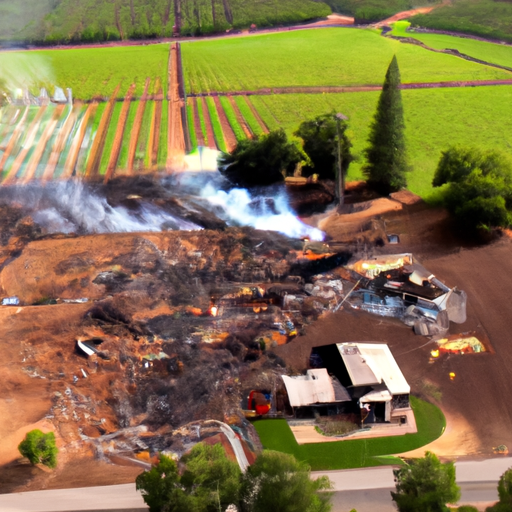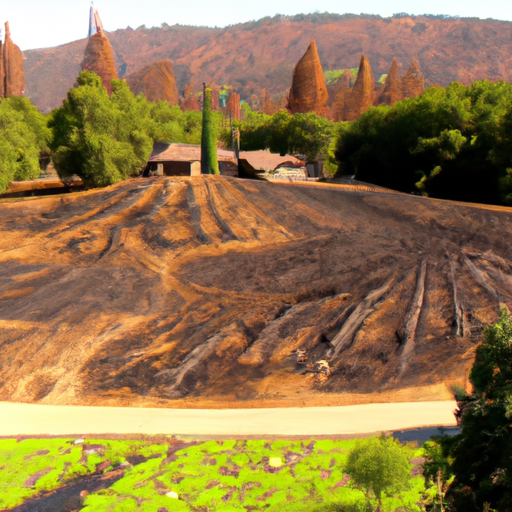
The Impact of the Glass Fire on Napa Valley’s Vineyards and Wineries
The Impact of the Glass Fire on Napa Valley’s Vineyards and Wineries
The year 2020 will forever be etched in the memory of Napa Valley residents as the year they faced one of the most devastating wildfires in the region’s history. The Glass Fire, which ignited on September 27th, quickly spread across the picturesque landscape, leaving destruction in its wake. As the flames engulfed the hillsides, vineyards and wineries, the heart of Napa Valley’s economy, were not spared from the tragedy.
Napa Valley is renowned worldwide for its exquisite wines, and the region’s vineyards and wineries are the lifeblood of its economy. However, the Glass Fire brought about a catastrophic blow to this thriving industry. The fire’s relentless path through the valley resulted in the destruction of numerous vineyards and wineries, leaving winemakers and grape growers grappling with the aftermath.
The flames ravaged acres upon acres of vineyards, reducing once lush green landscapes to charred remains. The intense heat and smoke caused irreparable damage to grapevines, leaving winemakers facing the grim reality of lost harvests and years of hard work gone up in smoke. The loss of these vineyards not only impacts the immediate wine production but also has long-term consequences for the industry as a whole.
In addition to the destruction of vineyards, the Glass Fire also engulfed several iconic wineries in its path. These wineries, some of which had been in operation for generations, were reduced to ashes, leaving behind only memories and a sense of profound loss. The destruction of these historic establishments not only affects the owners and employees but also the cultural heritage of Napa Valley.
The economic impact of the Glass Fire on Napa Valley’s vineyards and wineries cannot be overstated. The wine industry is a significant contributor to the region’s economy, generating billions of dollars in revenue each year. With the destruction caused by the fire, the loss of jobs and revenue is staggering. Wineries that managed to escape the flames still face challenges, as the smoke from the fire can taint the grapes, affecting the quality of the wine produced.
Rebuilding and recovery will be a long and arduous process for Napa Valley’s vineyards and wineries. The resilience of the community, however, is evident as winemakers and grape growers come together to support one another. Efforts are underway to replant vineyards and rebuild wineries, but it will take years for the industry to fully recover from the devastation caused by the Glass Fire.
The impact of the Glass Fire extends beyond the immediate loss of vineyards and wineries. The fire serves as a stark reminder of the increasing threat of wildfires in California due to climate change. As temperatures rise and drought conditions persist, the risk of wildfires becomes more pronounced. The wine industry, along with other sectors, must adapt and implement strategies to mitigate the impact of future fires.
Despite the devastation caused by the Glass Fire, there is hope for Napa Valley’s vineyards and wineries. The region’s reputation for producing exceptional wines remains intact, and the resilience of its people will undoubtedly lead to a remarkable recovery. As the community rebuilds, it is crucial for wine enthusiasts and consumers to support Napa Valley by continuing to enjoy and appreciate its world-class wines. Together, we can help Napa Valley rise from the ashes and reclaim its position as a premier wine destination.
Assessing the Environmental Damage Caused by the Devastating Glass Fire

The devastating Glass Fire that struck Napa Valley in 2020 left a trail of destruction in its wake. As the flames raged through the picturesque landscape, homes were reduced to ashes, vineyards were scorched, and the environment suffered significant damage. In this section, we will assess the environmental impact caused by this tragic event.
One of the most immediate and visible consequences of the Glass Fire was the destruction of vegetation. The fire consumed vast areas of forests, grasslands, and shrublands, leaving behind a barren and charred landscape. The loss of vegetation not only disrupts the natural ecosystem but also increases the risk of soil erosion and landslides. Without the protective cover of plants, heavy rains can wash away the topsoil, leading to further environmental degradation.
Furthermore, the fire had a devastating effect on wildlife in the region. Many animals were unable to escape the fast-moving flames, resulting in the loss of countless lives. The destruction of their habitats also means that surviving animals are left without food and shelter, forcing them to seek refuge elsewhere. This disruption to the local wildlife population can have long-term consequences for the ecosystem, as it may take years for the affected species to recover, if they can at all.
The Glass Fire also had a significant impact on air quality in the area. The burning of vegetation and structures released large amounts of smoke and pollutants into the atmosphere, creating a hazardous environment for residents and emergency responders. The smoke from the fire traveled far beyond Napa Valley, affecting neighboring communities and even reaching as far as the Bay Area. The poor air quality posed serious health risks, particularly for individuals with respiratory conditions, and required the implementation of evacuation orders and the distribution of masks to protect against the harmful particles.
In addition to the immediate effects, the Glass Fire also poses long-term challenges for the region’s water resources. The fire can alter the hydrological cycle by changing the way water is absorbed and retained in the soil. The intense heat can cause the soil to become hydrophobic, preventing water from infiltrating and increasing the risk of flash floods and mudslides during heavy rainfall. The loss of vegetation also reduces the natural filtration system that helps purify water, potentially leading to contamination of water sources.
The environmental damage caused by the Glass Fire extends beyond the physical landscape. The fire’s impact on the local economy and tourism industry cannot be overlooked. Napa Valley is renowned for its vineyards and wineries, which suffered significant damage during the fire. The loss of vineyards not only affects the livelihoods of those directly involved in the industry but also has a ripple effect on the entire community. The road to recovery will be long and arduous, as it will require rebuilding infrastructure, replanting vineyards, and restoring the natural beauty of the region.
In conclusion, the Glass Fire that ravaged Napa Valley in 2020 had a devastating impact on the environment. The loss of vegetation, destruction of wildlife habitats, poor air quality, and long-term challenges to water resources are just a few of the consequences that the region now faces. The road to recovery will be challenging, but with concerted efforts and support, Napa Valley can rebuild and restore its natural beauty once again.
Rebuilding and Recovery Efforts in Napa Valley After the Tragic Glass Fire
The Glass Fire that ravaged Napa Valley in 2020 left a trail of destruction in its wake. As the flames engulfed the picturesque vineyards and wineries, the heart of this renowned wine region was shattered. However, amidst the devastation, the resilient spirit of the community emerged, and the rebuilding and recovery efforts began.
In the aftermath of the fire, the first priority was to ensure the safety and well-being of the residents. Evacuation orders were issued, and emergency services worked tirelessly to contain the blaze. Once the immediate danger had passed, attention turned to assessing the damage and formulating a plan for rebuilding.
The fire had destroyed over 1,500 structures, including homes, businesses, and wineries. The loss was not only financial but also deeply emotional for the people of Napa Valley. Many families had lived in the area for generations, and their livelihoods were intricately tied to the wine industry. The road to recovery seemed long and arduous, but the community was determined to rise from the ashes.
Government agencies, non-profit organizations, and volunteers joined forces to provide support and resources to those affected by the fire. The Federal Emergency Management Agency (FEMA) offered assistance to homeowners and business owners, helping them navigate the complex process of rebuilding and accessing financial aid. Local organizations, such as the Napa Valley Community Foundation, established relief funds to provide immediate assistance to those in need.
One of the most significant challenges faced by the community was the restoration of the vineyards and wineries. The fire had not only destroyed buildings but also scorched acres of vineyards, leaving behind charred remains. The loss of these vineyards meant a significant blow to the wine industry, which is the lifeblood of Napa Valley.
However, the resilience and determination of the winemakers and grape growers were evident as they began the process of replanting and rejuvenating the vineyards. With the support of agricultural experts and scientists, they carefully assessed the soil conditions and selected the appropriate grape varieties for replanting. It was a painstaking process that required patience and expertise, but the community was determined to restore Napa Valley’s vineyards to their former glory.
In addition to the physical restoration, efforts were also made to support the emotional well-being of the community. Counseling services were made available to those who had experienced trauma and loss. Community events and gatherings were organized to foster a sense of unity and solidarity among the residents. The healing process was not just about rebuilding structures; it was about rebuilding lives and restoring hope.
As time passed, signs of progress began to emerge. New buildings rose from the ashes, and vineyards once again bore fruit. The resilience and determination of the community had paid off, and Napa Valley was on its way to recovery. The tragedy of the Glass Fire had left scars, but it had also revealed the strength and unity of the people.
Today, Napa Valley stands as a testament to the power of resilience and community. The rebuilding and recovery efforts have not only restored the physical landscape but also strengthened the bonds among the residents. The tragic encounter with the Glass Fire will forever be etched in the history of Napa Valley, but it will also serve as a reminder of the indomitable spirit that can overcome even the most devastating of challenges.






